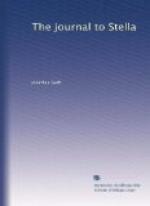The Journal to Stella is interesting from many points of view: for its bearing upon Swift’s relations with Stella and upon his own character; for the light which it throws upon the history of the time and upon prominent men of the day; and for the illustrations it contains of the social life of people of various classes in London and elsewhere. The fact that it was written without any thought of publication is one of its greatest attractions. Swift jotted down his opinions, his hopes, his disappointments, without thought of their being seen by anybody but his correspondents. The letters are transparently natural. It has been said more than once that the Journal, by the nature of the case, contains no full-length portraits, and hardly any sketches. Swift mentions the people he met, but rarely stops to draw a picture of them. But though this is true, the casual remarks which he makes often give a vivid impression of what he thought of the person of whom he is speaking, and in many cases those few words form a chief part of our general estimate of the man. There are but few people of note at the time who are not mentioned in these pages. We see Queen Anne holding a Drawing-room in her bedroom: “she looked at us round with her fan in her mouth, and once a minute said about three words to some that were nearest her.” We see Harley, afterwards the Earl of Oxford, “a pure trifler,” who was always putting off important business; Bolingbroke, “a thorough rake”; the prudent Lord Dartmouth, the other Secretary of State, from whom Swift could never “work out a dinner.” There is Marlborough, “covetous as Hell, and ambitious as the prince of it,” yet a great general and unduly pressed by the Tories; and the volatile Earl of Peterborough, “above fifty, and as active as one of five-and-twenty”—“the ramblingest lying rogue on earth.” We meet poor Congreve, nearly blind, and in fear of losing his commissionership; the kindly Arbuthnot, the Queen’s physician; Addison, whom Swift met more and more rarely, busy with the preparation and production of Cato; Steele, careless as ever, neglecting important appointments, and “governed by his wife most abominably”; Prior, poet and diplomatist, with a “lean carcass”; and young Berkeley of Trinity College, Dublin, “a very ingenious man and great philosopher,” whom Swift determined to favour as much as he could. Mrs. Masham, the Duchess of Somerset, the Duchess of Shrewsbury, the Duchess of Hamilton, Lady Betty Germaine, and many other ladies appear with more or less distinctness; besides a host of people of less note, of whom we often know little but what Swift tells us.




